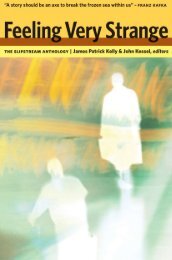The Curse of the Wer.. - Site de Thomas - Free
The Curse of the Wer.. - Site de Thomas - Free
The Curse of the Wer.. - Site de Thomas - Free
Create successful ePaper yourself
Turn your PDF publications into a flip-book with our unique Google optimized e-Paper software.
158 THE CURSE OF THE WEREWOLF<br />
74. Angelo <strong>de</strong> Gubernatis, Zoological Mythology or <strong>the</strong> Legends <strong>of</strong> Animals,<br />
vol. 2 (London: Trübner, 1872), pp. 422–3.<br />
75. Baring-Gould, <strong>The</strong> Book <strong>of</strong> <strong>Wer</strong>e-wolves, p. 179.<br />
76. Cox, <strong>The</strong> Mythology <strong>of</strong> <strong>the</strong> Aryan Nations, vol. 1, pp. 232–3.<br />
77. Dorson, <strong>The</strong> British Folklorists, pp. 172–4.<br />
78. Kelly, Curiousities <strong>of</strong> Indo-European Tradition and Folk-Lore, p. 243.<br />
79. Tylor, Primitive Culture, p. 315.<br />
80. Ibid., p. 308.<br />
81. Dorson, <strong>The</strong> British Folklorists, p. 193.<br />
82. Charles Hardwick, ‘<strong>Wer</strong>ewolves and <strong>the</strong> Transmigration <strong>of</strong> Souls’, in<br />
C. Hardwick, Traditions, Superstitions and Folklore (Manchester: A.<br />
Ireland/London: Simpkin, Marshall, 1872), pp. 224–41.<br />
83. Fiske, ‘<strong>Wer</strong>ewolves and Swanmai<strong>de</strong>ns’, p. 70.<br />
84. Georg G. Iggers, <strong>The</strong> German Conception <strong>of</strong> History: <strong>The</strong> National Tradition<br />
<strong>of</strong> Historical Thought from Her<strong>de</strong>r to <strong>the</strong> Present (Middletown CT:<br />
Wesleyan University Press, 1968), p. 63.<br />
85. Caroline Taylor Stewart, ‘<strong>The</strong> Origin <strong>of</strong> <strong>the</strong> <strong>Wer</strong>ewolf Superstition’,<br />
University <strong>of</strong> Missouri Studies: Social Science Series, vol. 2, no. 3 (April<br />
1909), p. 1.<br />
86. Ibid., p. 28.<br />
87. C.W. Leadbeater, ‘<strong>The</strong> Astral Plane’, in Transactions <strong>of</strong> <strong>the</strong> London Lodge<br />
<strong>of</strong> <strong>the</strong> <strong>The</strong>osophical Society 24 (April 1895), p. 39.<br />
88. Adolphe D’Assier, Posthumous Humanity: A Study <strong>of</strong> Phantoms (London:<br />
George Redway, 1887), p. 259.<br />
89. Fiske, ‘<strong>Wer</strong>ewolves and Swanmai<strong>de</strong>ns’, p. 70.<br />
90. Tylor, Primitive Culture, p. 308.<br />
91. Charles Darwin, <strong>The</strong> Expression <strong>of</strong> <strong>the</strong> Emotions in Man and Animals<br />
(1872) (Chicago: University <strong>of</strong> Chicago Press, 1965), p. 12.<br />
92. Hurley, <strong>The</strong> Gothic Body, p. 5.<br />
93. See, for example, Jean Bellemin-Noël, ‘Des formes fantastiques aux thèmes<br />
fantasmatiques’, Littérature 2 (May 1971), cited in Rosemary Jackson,<br />
Fantasy: <strong>The</strong> Literature <strong>of</strong> Subversion (New York: Methuen, 1981), p. 62;<br />
William Patrick Day, In <strong>the</strong> Circles <strong>of</strong> Fear and Desire: A Study <strong>of</strong> Gothic<br />
Fantasy (Chicago and London: University <strong>of</strong> Chicago Press, 1985), p.<br />
10.<br />
94. Sigmund Freud, cited in Lionel Trilling, <strong>The</strong> Liberal Imagination: Essays<br />
on Literature and Society (London: Secker & Warburg, 1951), p. 34.<br />
95. Sigmund Freud, Studies on Hysteria (1895), cited in Richard Wollheim,<br />
‘Introduction’ to S. Freud, <strong>The</strong> Case <strong>of</strong> <strong>the</strong> Wolf-Man: From <strong>the</strong> History<br />
<strong>of</strong> an Infantile Neurosis (San Francisco: Arion Press, 1993), p. 7.<br />
96. Hurley, <strong>The</strong> Gothic Body, pp. 16–17.<br />
97. Day, In <strong>the</strong> Circles <strong>of</strong> Fear and Desire, p. 51.





